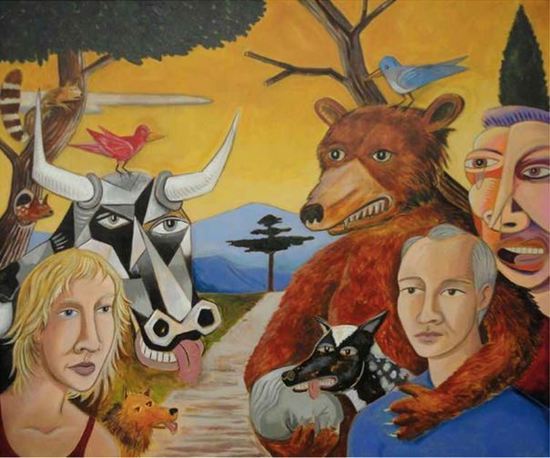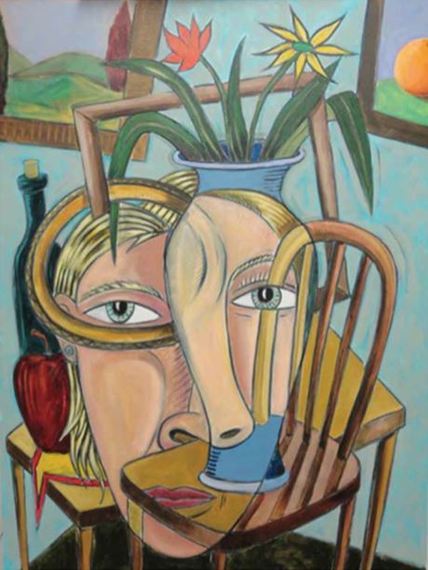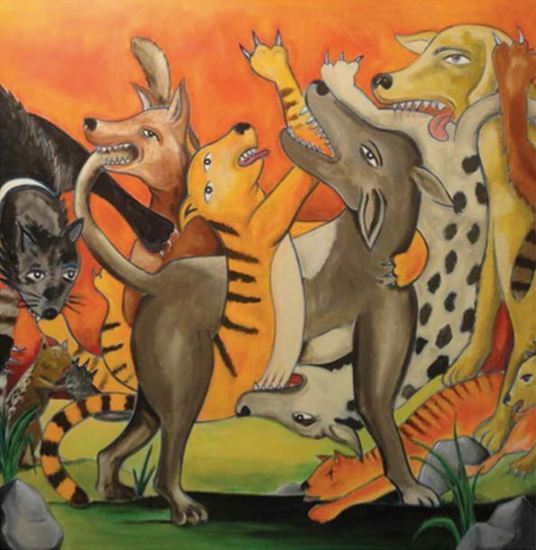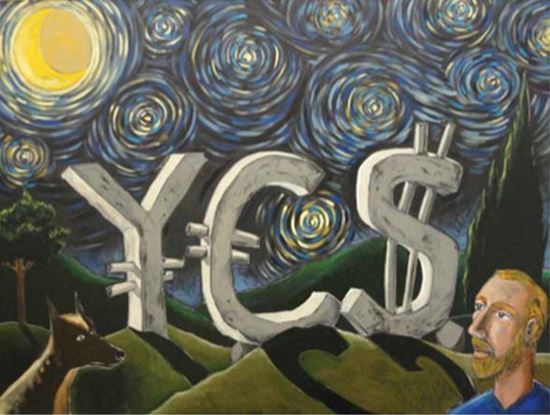Kelly Detweiler -- a painter whose work is on view at the John Natsoulas Center for the Arts in Davis, CA -- has invented a wide-eyed cast of characters to inhabit his loving yet sardonic paintings. Earnest, alert and just a bit spiritual Detweiler's actors and actresses are put through all kinds of trials and tribulations and yet somehow they never entirely lose their innocence: the artist who painted them likes them too much to let them be destroyed. He is at heart a nice guy.
Detweiler also works with a shaggy and anthropomorphized cast of animals who play roles suggestive of our more fierce and instinctive inner natures. Since he often works from ideas that bloom from his unconscious Detweiler has no problem letting humans and animals coexist in his mythological situations. In that sense he is like Picasso.
I recently interviewed Kelly and asked him about his background, his work, and his sense of humor.
John Seed Interviews Kelly Detweiler
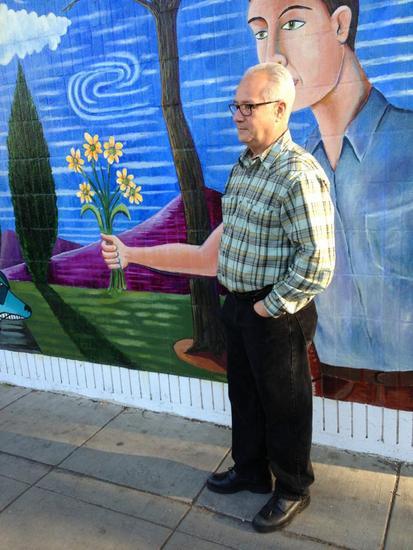
Kelly Detweiler: photo by John Seed
In your artist's statement you say that U.C. Davis was a "magical place" when you were a student there. Tell me about some of the people and experiences that made it that way.
Detweiler also works with a shaggy and anthropomorphized cast of animals who play roles suggestive of our more fierce and instinctive inner natures. Since he often works from ideas that bloom from his unconscious Detweiler has no problem letting humans and animals coexist in his mythological situations. In that sense he is like Picasso.
I recently interviewed Kelly and asked him about his background, his work, and his sense of humor.
John Seed Interviews Kelly Detweiler

U.C. Davis was a quiet little college town with a powerhouse faculty when I arrived. I was aware of almost all of the faculty and somewhat star struck to be working with Robert Arneson every day and to be able to interact regularly with Manuel Neri, Wayne Thiebaud, Roy De Forest, William Wiley and the rest of the faculty. I was amazed at how approachable these people were and what a great environment it was for making art.
Sacramento State also had Jim Nutt and Gladys Nielson and Carl Wirsum during that period of time so the entire region was alive with amazing artists who were on the edge of national recognition. David Gilhooly was there for my first year and he was a great role model because he worked so hard and really made you feel lazy if you weren't working all of the time. Out of six students in ceramics, I was the only one who knew how to fire the kilns and make clay so I had a teaching assistantship every semester I was there. Arneson knew I wanted to teach so he taught me many valuable lessons that have helped me as a teacher over the years.
This was a great time in the history of the department and I felt very lucky to be in the middle of so many artists I admired. What I really loved was that the structure was perfect for me at that time. I was able to do ceramics and painting at the same time. There were also an amazing group of graduate students, and many of them are still very visible in the art world today: Christopher Brown, Nancy Rubens, Arthur Gonzales, Leonard Kosianski and Katherine Sherwood to name a few.
"Economic Summit," acrylic on canvas, 60 x 72 inches, 2013
Your work blends social commentary with humor. Has it always been that way?
My work has always had a humorous edge to it. I was always attracted to artists whose work had a narrative humanistic edge and often it was manifested in humor. Clayton Bailey was an early influence, Roy de Forest, Jim Nutt and Peter Saul all had an edge of humor to their work and that was the stuff I was most attracted to. The social commentary has grown over the years with self-awareness and maturity. Having children has also affected my view on the world and forced me to speak out a little more forcefully in my work. The early work had social commentary, but usually about the interaction between the sexes. Now I often react to bigger more political issues, but they have to be something that comes out in my drawings.
"Framed," acrylic on wood, 42 x 36 inches, 2013
There is a quite a bit of Picasso in your work: tell me about your dialogue with him and what you have taken from his imagery, style and subjects.
I don't remember when I saw my first Picasso, but it was probably in Art History class at Grossmont College. It was pretty much a love affair from the start. I loved the distortion and the manipulation in Guernica. Here was a painting that was both visually interesting to me and was also an extremely powerful social commentary. As I grew older and was able to travel and see more and more Picasso paintings live I have gained more insight into his process and more appreciation for his ability to abstract reality and to invent.
He spoke directly to my sensibilities as an artist I was not interested in what was big in New York at that point or much of what the art magazines told me was important. Pop art had some attraction for me but those artists just outside the main track were the ones I was drawn to the most. From my perspective there was a huge gap between the early figurative work I liked from Europe and the newer art, which I was finding as a student. Picasso bridged the gap for me and he dealt with the figure in a manner I could embrace.
"Faculty Meeting," Acrylic on Canvas, 60 x 60 inches, 2008
Do you have a favorite painting from the past few years? If yes, tell me about it.
If I had to pick a favorite painting it might be "Faculty Meeting" which is a big painting of a group of dogs and cats fighting. Why is it my favorite? Maybe because of the subject matter, this issue of conflict amongst humans is universal. Homo sapiens fight about almost anything, religion, food, land, oil, relationships, skin color, you name it we fight.
The drawing for Faculty Meeting was made during an actual faculty meeting The idea for the painting came from a notion that Art Historians would prefer if we were dead so they could decide what we were doing and thinking. Having us around only complicates the process for them. Using animals to represent the two groups made me realize that I had communicated something much more universal about mankind, not just artists and art historians. The humorous edge also mimics the real situation in academia where we are all competing fiercely against each other for those low salaries.
"Crush," Acrylic on Wood, 42 x 30 inches, 2012
You have been teaching for a number of years. What do you try to give to your students, and what do you notice about the current crop?
I felt very let down when I started teaching and realized how little I actually knew. Consequently I want my students to go away with a strong foundation and an appreciation of how hard it really is to make art. I try to teach my students to be patient and that anything substantial does not come easy.
This generation of students is used to getting everything quick and easy.
I tell them that art is slow and hard and they will learn patience, persistence and good work habits in my class. I strongly feel that Art skills can help them in any discipline. It is the only class I know of where they can all have different answers and all be right. I really try to teach them what I missed out on as a student.
The period when I was in college was quite fluid intellectually, so it was possible to get a drawing teacher who did not know how to draw. Some stuff looked so easy that students wondered why learn all this academic stuff when I can jump right into something easy. They were convinced that they could be the next Pollock or Barnett Newman without too much difficulty. I try to show them that good abstraction comes from knowledge and usually from somewhere very academic. I try to take a very academic approach in my classes. I rarely show my own work to students because I don't want them to paint like me.
"Meltdown," Acrylic on Canvas, 60 x 72 inches, 2010
Is it fair to say that you are serious and grounded as a man, but something of a comedian as an artist?
Humor is a way to approach serious issues and make them palatable. I am definitely grounded in my real life, because you can't be a good parent if you are aren't grounded and being a good parent is important to me. I see things now that I want to comment on that would be very heavy and dark if I just went right at the issue, so I usually take the issue on as a problem to solve with line, color and a touch of humor.
In the painting "Meltdown", there was a big nationwide financial mess, which continues to plague our economy. Banks were getting bailed out but real people were losing everything. Greed is a central issue in this dialogue but I chose to approach this issue with some humor and still not diminish the importance the problem. I like it when somebody looks at one of my pieces and thinks they have it figured out immediately, but then comes back later to realize there was something substantial behind the colorful façade.
"Starry YES," acrylic on canvas, 36 x 28 inches, 2012
One of your recent series features the idea of YES Industries: tell me more about that.
YES Industries grew out of this idea that greed has taken over. The YES pieces also speak to the art world in general and to the rise of artists who don't even touch their own work. I have created YES donation centers, which eliminate the collectors and put the money right in the artist's hand.
What would you like people to know about the work in your current show at Natsoulas Gallery?
Everything in the Natsoulas show is new work. I have been on sabbatical for a year and I have spent the majority of the year working toward this exhibit. Even though I may be humorous, I am also very serious about my work. I realized quite a while ago that I have somewhat unique vision of the world and that my imagination is one of my strengths. I believe that what UC Davis nurtured in many of the students of my era was the strength of the individual vision no matter what the approach or media.
Kelly Detweiler
Opening: Friday, November 8, 2013 7:00 pm
521 First Street
Davis, CA 95618
A full-color catalog is available.

